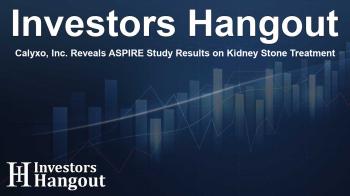Calyxo, Inc. Reveals ASPIRE Study Results on Kidney Stone Treatment

Groundbreaking Results from the ASPIRE Study
Calyxo, Inc., a forward-thinking medical device company, proudly announces significant outcomes from their ASPIRE clinical trial. The study, recently published in the respected Journal of Endourology, highlights the remarkable effectiveness of the SURE procedure using the CVAC Aspiration System for kidney stone clearance. Initial findings reveal that the SURE method outperforms traditional ureteroscopy in both stone clearance and residual stone volume.
ASPIRE Trial Overview
The ASPIRE trial, which stands for ASPiration to Improve Renal Calculi Removal Effectiveness, is a pivotal exploration into new methods of treating kidney stones. This multi-center, randomized, non-inferiority study involved 101 patients treated across 11 institutions. Participants were split between those receiving the innovative SURE procedure and those undergoing standard ureteroscopy from mid-2021 through early 2023.
Key Findings and Statistical Insights
Results from the trial indicate that the SURE procedure resulted in a significantly higher rate of stone clearance. The mean reduction in stone volume was an impressive 97% for patients utilizing the SURE method, compared to 93% for those receiving standard ureteroscopy. Notably, the residual stone volume (RSV) was also lower in patients who underwent the SURE procedure, bringing the mean RSV down to 14.3 mm³, while the traditional URS treatments recorded a significantly higher mean RSV of 70.2 mm³. These findings are statistically significant, demonstrating the superior efficacy of the CVAC System in kidney stone treatment.
Benefits of the CVAC Aspiration System
Dr. Brian R. Matlaga, lead author of the study and Professor of Urology at Johns Hopkins University, emphasized the advantages of the new technology. He noted that the CVAC aspiration system maintains high efficacy even with larger baseline stone volumes. This is contrary to traditional ureteroscopy, where treatment efficacy tends to diminish as the stone size increases, potentially leading to complications for the patient.
Progress in Measuring Treatment Success
One noteworthy aspect of the ASPIRE study is its approach to defining success in kidney stone treatment. Rather than relying solely on the stone-free rate (SFR), which can often be inconsistent due to variable reporting standards, the study utilized continuous measures such as stone clearance percentages and absolute residual stone volume. This more refined approach results in a clearer understanding of treatment efficacy and its clinical significance.
Future Implications for Kidney Stone Treatment
Joe Catanese, the President and CEO of Calyxo, expressed optimism about the implications of the ASPIRE results. The findings are expected to ignite further research into kidney stone treatments while highlighting the CVAC System's capabilities within the medical community. With its FDA clearance, the CVAC System is now recognized as a minimally invasive alternative designed for effective kidney stone removal.
Understanding Kidney Stones
Kidney stones affect approximately 10% of the population at some point in their lives, leading to significant pain and healthcare expenses. The healthcare costs associated with treating kidney stones are substantial, with projections indicating that direct treatment costs may reach $4.1 billion annually by 2030.
About Calyxo, Inc.
Calyxo, Inc. stands at the forefront of medical innovation, dedicated to enhancing the lives of patients suffering from kidney stones. By developing progressive solutions that empower urologists, Calyxo aims to achieve unparalleled clinical outcomes. For additional information about Calyxo and its advancements in medical devices, visit calyxoinc.com.
Frequently Asked Questions
What is the ASPIRE study about?
The ASPIRE study investigates the effectiveness of the SURE procedure using the CVAC Aspiration System in comparison to traditional ureteroscopy for kidney stone removal.
What were the key outcomes of the ASPIRE study?
The study found that the SURE procedure achieved higher stone clearance rates and lower residual stone volumes compared to standard ureteroscopy.
How does the CVAC system work?
The CVAC system combines irrigation and vacuum aspiration techniques to clear stone fragments efficiently during and after procedures.
Why is the measurement of residual stone volume important?
Measuring residual stone volume provides a clearer indication of treatment success and potential complications than the traditional stone-free rate.
What is Calyxo, Inc.'s mission?
Calyxo's mission is to improve kidney stone treatment outcomes through innovative solutions that prioritize patient safety and clinical effectiveness.
About Investors Hangout
Investors Hangout is a leading online stock forum for financial discussion and learning, offering a wide range of free tools and resources. It draws in traders of all levels, who exchange market knowledge, investigate trading tactics, and keep an eye on industry developments in real time. Featuring financial articles, stock message boards, quotes, charts, company profiles, and live news updates. Through cooperative learning and a wealth of informational resources, it helps users from novices creating their first portfolios to experts honing their techniques. Join Investors Hangout today: https://investorshangout.com/
Disclaimer: The content of this article is solely for general informational purposes only; it does not represent legal, financial, or investment advice. Investors Hangout does not offer financial advice; the author is not a licensed financial advisor. Consult a qualified advisor before making any financial or investment decisions based on this article. The author's interpretation of publicly available data shapes the opinions presented here; as a result, they should not be taken as advice to purchase, sell, or hold any securities mentioned or any other investments. The author does not guarantee the accuracy, completeness, or timeliness of any material, providing it "as is." Information and market conditions may change; past performance is not indicative of future outcomes. If any of the material offered here is inaccurate, please contact us for corrections.
